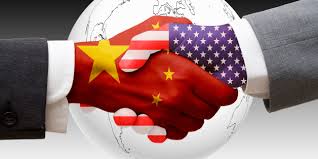
Amongst the clearest signs that the Trump administration's trade war with China is hitting the United States is the slowing down of sale of Apple Inc in China and a sudden drop in the manufacturing economy in the US. And according to analysts, these factors could lead both the countries – China and the US, to bring an end to the trade war.
China’s economy is already showing signs of a slowdown. However with Apple announcing the its China sales had dropped off sharply in November offer more proof that US companies and possibly the domestic US economy were being hurt by the trade war with China. Soon after the dampening announcement by Apple, Thursday’s ISM manufacturing data showed that it had reached its lowest point in more than the last two years.
"This is probably one of the first data points that indicates things domestically in the U.S. economy might be slowing a bit," said Michael Gapen, chief U.S. economist at Barclays.
"Factories are struggling with the uncertainties around tariffs…as well as the appreciating dollar (the broad trade-weighted dollar index is up about 10 percent from its early-2018 lows), two factors that will likely hurt the factory sector worse than other parts of the economy," Stephen Stanley, chief economist at Amherst Pierpont, wrote in a note.
There can be a solution out of the trade negotiations between the two largest economies of the world because of the snowballing of negative news for the U.S. economy and the fact that Chinese economy had already weakened, said Dan Clifton, head of policy research at Strategas Research. In December, the first contraction in 19 months was reported in a private survey on China's manufacturing sector. In Novemberm the Caixin/Markit Manufacturing Purchasing Managers' Index fell to 49.7 from 50.2.
"The incentives are lined up," said Clifton. It is expected that China would be eager to get a solution to the trade spat because of weakness in China but there were concerns whether the US would be eager enough to strike a deal by March 1 when the 90 day trade truce ends. "That's starting to be reconsidered," he said.
"I believe on Nov. 1, the president's tone changed towards a trade deal. It's not a subtle change. It's very direct. He was talking about tariffs, tariffs, tariffs, and then all of a sudden he was talking about doing a great deal."
The 90 day truce in the trade war was announced after a n\meeting of United States president Donald Trump and Chinese President Xi Jinping in Sao Paolo in Argentina on the sidelines of G20 summit. The two parties agreed to try and resolve the trade disputes by March 1, 2019.
While an opportunity for a trade exists given the current economic situations in both countries, bothing can be said for sure, said Cesar Rojas, Citigroup global economist.
"There is a window of opportunity for the U.S. and China to come to a deal," he said. "Growth is moderating in China, equity markets have been falling in the U.S. and China and this basically opens a window of opportunity. This may close soon."
(Source:www.cnbc.com)
China’s economy is already showing signs of a slowdown. However with Apple announcing the its China sales had dropped off sharply in November offer more proof that US companies and possibly the domestic US economy were being hurt by the trade war with China. Soon after the dampening announcement by Apple, Thursday’s ISM manufacturing data showed that it had reached its lowest point in more than the last two years.
"This is probably one of the first data points that indicates things domestically in the U.S. economy might be slowing a bit," said Michael Gapen, chief U.S. economist at Barclays.
"Factories are struggling with the uncertainties around tariffs…as well as the appreciating dollar (the broad trade-weighted dollar index is up about 10 percent from its early-2018 lows), two factors that will likely hurt the factory sector worse than other parts of the economy," Stephen Stanley, chief economist at Amherst Pierpont, wrote in a note.
There can be a solution out of the trade negotiations between the two largest economies of the world because of the snowballing of negative news for the U.S. economy and the fact that Chinese economy had already weakened, said Dan Clifton, head of policy research at Strategas Research. In December, the first contraction in 19 months was reported in a private survey on China's manufacturing sector. In Novemberm the Caixin/Markit Manufacturing Purchasing Managers' Index fell to 49.7 from 50.2.
"The incentives are lined up," said Clifton. It is expected that China would be eager to get a solution to the trade spat because of weakness in China but there were concerns whether the US would be eager enough to strike a deal by March 1 when the 90 day trade truce ends. "That's starting to be reconsidered," he said.
"I believe on Nov. 1, the president's tone changed towards a trade deal. It's not a subtle change. It's very direct. He was talking about tariffs, tariffs, tariffs, and then all of a sudden he was talking about doing a great deal."
The 90 day truce in the trade war was announced after a n\meeting of United States president Donald Trump and Chinese President Xi Jinping in Sao Paolo in Argentina on the sidelines of G20 summit. The two parties agreed to try and resolve the trade disputes by March 1, 2019.
While an opportunity for a trade exists given the current economic situations in both countries, bothing can be said for sure, said Cesar Rojas, Citigroup global economist.
"There is a window of opportunity for the U.S. and China to come to a deal," he said. "Growth is moderating in China, equity markets have been falling in the U.S. and China and this basically opens a window of opportunity. This may close soon."
(Source:www.cnbc.com)














